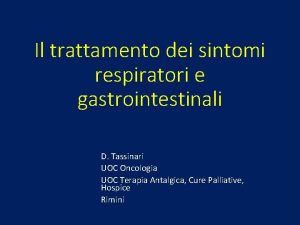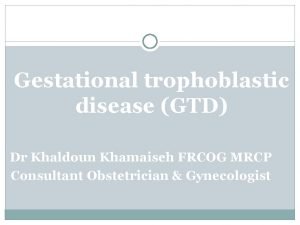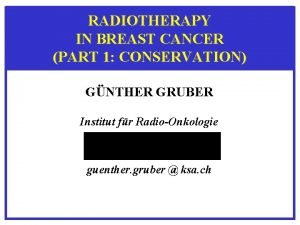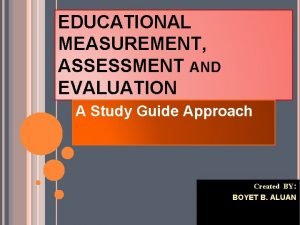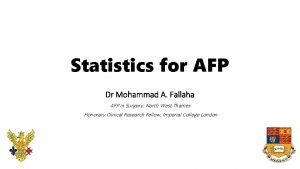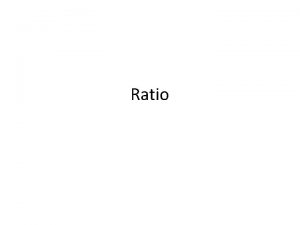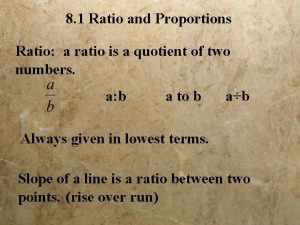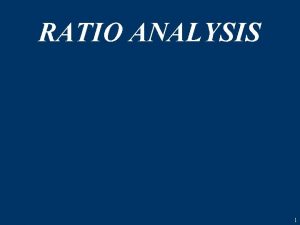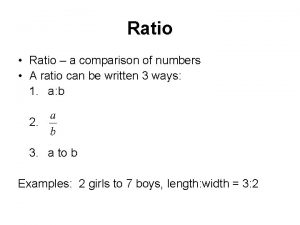Prognostic Value of Quantitative Flow Ratio measured Immediately


















- Slides: 18

Prognostic Value of Quantitative Flow Ratio measured Immediately after Successful Stent Implantation: the International Multicenter Prospective HAWKEYE study (Clinical. Trials. gov, number NCT 02811796)

Potential conflicts of interest Speaker's name : Simone Biscaglia ☑ I do not have any potential conflict of interest to declare

Why this study? • PCI optimization based on imaging or physiology improves outcome 1, 2, but in clinical practice, it is applied in less than 10% of patients 3, 4 • Quantitative flow ratio (QFR) is an easy-to-use physiology assessment requiring neither adenosine nor guidewire. For these reasons, QFR seems appealing for post-PCI assessment • The FAVOR II E-J 5 and FAVOR II China 6 studies confirmed the diagnostic accuracy of QFR (vs. the gold standard FFR) in identifying hemodinamically-significant coronary stenoses • It is unclear whether QFR value post PCI is able to discriminate adverse outcome since no prospective evaluation has been performed 1. 2. 3. Agarwal SK et al. JACC Cardiovasc Interv. 2016; 9: 1022 -31. Zhang J et al. J Am Coll Cardiol 2018; 72: 3126– 37 Tebaldi M, et al. JACC Cardiovasc Interv. 2018; 11: 1482 -1491 4. 5. 6. Koskinas KC et al. Eurointervention 2018; 14: e 475 -484 Westra J et al. J Am Heart Assoc 2018; 7: e 009603 Xu B et al J Am Coll Cardiol 2017; 70: 3077

Why this study? • In addition, QFR could theoretically elucidate the mechanism of suboptimal outcome after PCI, namely: Suboptimal stent deployment Untreated lesion Diffuse disease

What did we study? • The hypothesis of the HAWKEYE study was to test whether QFR value post-stenting is related to adverse events in the follow-up in consecutive patients receiving successful implantation of second-generation DES and complete revascularization • The relationship between post-PCI QFR values and clinical outcome was investigated at vessel level

How was the study executed? • HAWKEYE was an investigator-driven, prospective, international, multicenter study • It was conducted at 7 centers in 2 countries (Italy and Spain), from June 2016 to July 2017 Principal Investigators Executive Committee Simone Biscaglia Azienda Ospedaliero Universitaria di Ferrara, Ferrara Salvatore Geraci S. Giovanni di Dio Hospital, Agrigento Gianluca Campo Azienda Ospedaliero Universitaria di Ferrara, Ferrara Salvatore Brugaletta Hospital Clínic, Barcelona Giuseppe Mezzapelle Giovanni Paolo II Hospital, Sciacca Emanuele Barbato Federico II University, Naples Alfonso Ielasi S. Ambrogio Cardio-Thoracic Center, Milan Domenico Di Girolamo A. O. Sant'Anna e San Sebastiano, Caserta Enrico Cerrato S. Luigi Gonzaga University Hospital, Rivoli Matteo Tebaldi Azienda Ospedaliero Universitaria di Ferrara, Ferrara

How was the study executed? Inclusion criteria: i. Successful PCI ii. Complete revascularization iii. Second-generation DES implantation iv. Signed informed consent Exclusion criteria: i. STEMI ii. Left Main, ostial RCA, CABG iii. Arrhythmias or tachycardia iv. Life expectancy <1 year • Follow-up: 629 [584 -746] days • Study Population: 602 patients [751 treated vessels] • Primary endpoint: vessel-oriented composite endpoint (VOCE), composite of vessel-related cardiovascular death, vessel-related MI, and target vessel revascularization (TVR)

What are the essential results? Patients’ and vessels characteristics Vessels (n=751) Patients (n=602) Age, years Clinical presentation, no. (%) NSTEACS SIHD Angiographic disease severity Multivessel disease, no (%) SYNTAX score, point 68 [60 -77] Number of stents, no 1 [1 -2] 402 (67) 200 (33) Diameter of stent, mm 3 [3 -3. 5] Total stent length, mm 30 [24 -32] 125 (21) 14 [7 -21] Postdilatation, no. (%) 627 (87) Median QFR: 0. 97 [0. 92 -0. 99] Range: 0. 63 -1. 00

What are the essential results? VOCE stratified according to post-PCI QFR • 77 events were detected in 53 (7%) treated vessels • At Cox regression, post-PCI QFR emerged as an independent predictor of the primary endpoint [HR 0. 56, 95%CI: 0. 46 -0. 68]

What are the essential results? • ROC curve analysis identified a post-PCI QFR cut-off of ≤ 0. 89 as having the best predictive accuracy for VOCE (AUC 0. 77, 95%CI 0. 74 -0. 80, p<0. 001, sensitivity 60%, specificity 87%) • Overall, 123 (16%) vessels had post-PCI QFR ≤ 0. 89 Location of QFR drop in vessels with suboptimal result Diffuse disease 34% HR for VOCE after correction: Combination 21% 2. 91, 95%CI 1. 63 -5. 19, p<0. 001 25% 3. 5% Untreated lesion 32% In stent drop 13% • Focal drop outside stent in 32% of the cases • Actionable in 66% of the cases

Why is this important? • Post-PCI QFR measurement identified a relatively small number of vessels (~16%) with suboptimal final result that is associated with poor outcome • In these vessels, QFR could discriminate whether the issue is related to suboptimal stent deployment, unnoticed lesion or diffuse disease • Due to low number of vessels and events, our speculations should be considered preliminary and should be confirmed in future bigger studies

The essentials to remember • Why? Post-PCI functional assessment improves outcome but is rarely utilized • What? Post-PCI QFR value relationship with vessel-oriented composite endpoint (VOCE) • How? Investigator-driven, prospective, international, multicenter study • What are the results? VOCE is 3 fold-higher in vessels with post-PCI QFR≤ 0. 89 • Why is this important? Post-PCI QFR highly correlates with prognosis and is applicable in most of the cases

Back-up slides

Definitions • Focal drop was defined as ≥ 0. 05 units step-down in < 15 mm segment with subsequent curve plateau • Diffuse disease was defined as progressive step-down in > 15 mm segment • Instent drop was defined as ≥ 0. 05 units step-down within stent + 5 mm proximally and distally

Study flow chart

What are the essential results? Age, years Female sex, no. (%) BMI, Kg/m 2 CV risk factors, no. (%) Diabetes Hypertension Hyperlipidemia Current smoker Medical history, no. (%) MI PCI CVA PAD Chronic kidney disease * Clinical presentation, no. (%) NSTEACS SIHD Angiographic disease severity Multivessel disease, no (%) SYNTAX score, point Contrast media, ml Patients (n=602) 68 [60 -77] 159 (26) 26. 5 [24. 3 -29. 4] 139 (23) 444 (74) 336 (56) 114 (19) 133 (22) 147 (24) 9 (1. 5) 39 (6. 5) 47 (7. 8) 402 (67) 200 (33) 125 (21) 14 [7 -21] 170 [136 -220] Location, no (%) LAD LCx RCA Quantitative coronary angiography Pre-PCI RVD, mm Pre-PCI diameter stenosis, % Pre-PCI lesion length, mm Post-PCI diameter stenosis, % Procedural data Number of stents, no Diameter of stents, mm Total length of stents, mm Postdilatation, no. (%) Vessels (n=751) 356 (48) 184 (24) 211 (28) 2. 8 [2. 3 -3. 2] 62 [55 -76] 21 [17 -30] 11 [9 -16] 1 [1 -2] 3 [3 -3. 5] 30 [24 -32] 627 (87)

Per patient analysis Patients (n=602) Pts with QFR ≤ 0. 89 (n=115) Pts with QFR >0. 89 (n=487) p Primary endpoint, no (%) Composite of CV death, TVMI, TVR 48 (7. 9) 30 (26) 18 (3. 7) <0. 001 11 (1. 8) 7 (6) 4 (0. 8) 0. 007 21 (3. 5) 11 (9. 5) 10 (2) 0. 002 40 (6. 6) 25 (22) 15 (3) <0. 001 Secondary endpoints, no. (%) CV death TVMI TVR

Why is this important? HAWKEYE II trial – 1100 patients Angiographically successful PCI with 2 nd generation DES 1: 1 randomization QFR guided optimization No additional optimization Threshold for further intervention: 0. 89 • If drop focal inside stent: PD • If drop focal outside: additional stent • If diffuse drop: OMT Primary endpoint: 1 -year VOCE Enrollment start: Q 1 2020
 Contoh value creation adalah
Contoh value creation adalah Constant pressure analysis chart legend
Constant pressure analysis chart legend Who prognostic scoring system gtn
Who prognostic scoring system gtn Choriocarcenoma
Choriocarcenoma Emaco regimen
Emaco regimen Palliative prognostic index
Palliative prognostic index Figo prognostic scoring system gtn
Figo prognostic scoring system gtn Van nuys prognostic index
Van nuys prognostic index Concept map of measurement assessment and evaluation
Concept map of measurement assessment and evaluation Exclamation in reported speech
Exclamation in reported speech If a laboratory fire erupts immediately
If a laboratory fire erupts immediately If a laboratory fire erupts, immediately
If a laboratory fire erupts, immediately What colour are the reflective studs
What colour are the reflective studs Msha immediately reportable
Msha immediately reportable Hazard ratio vs odds ratio
Hazard ratio vs odds ratio Velocity ratio in gear
Velocity ratio in gear Acid test ratio and quick ratio
Acid test ratio and quick ratio Secondary reinforcers
Secondary reinforcers Dihybrid cross genotypic ratio
Dihybrid cross genotypic ratio





